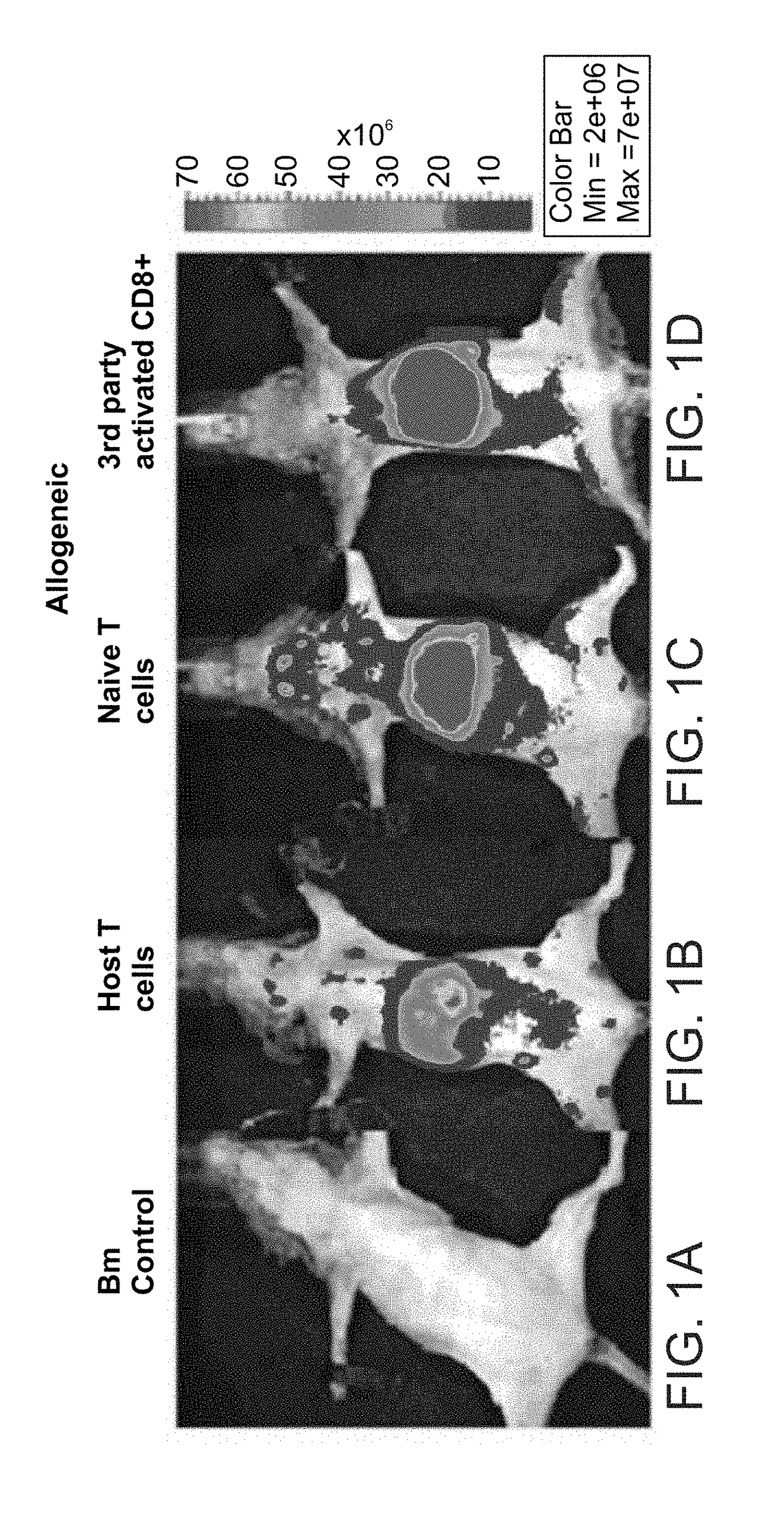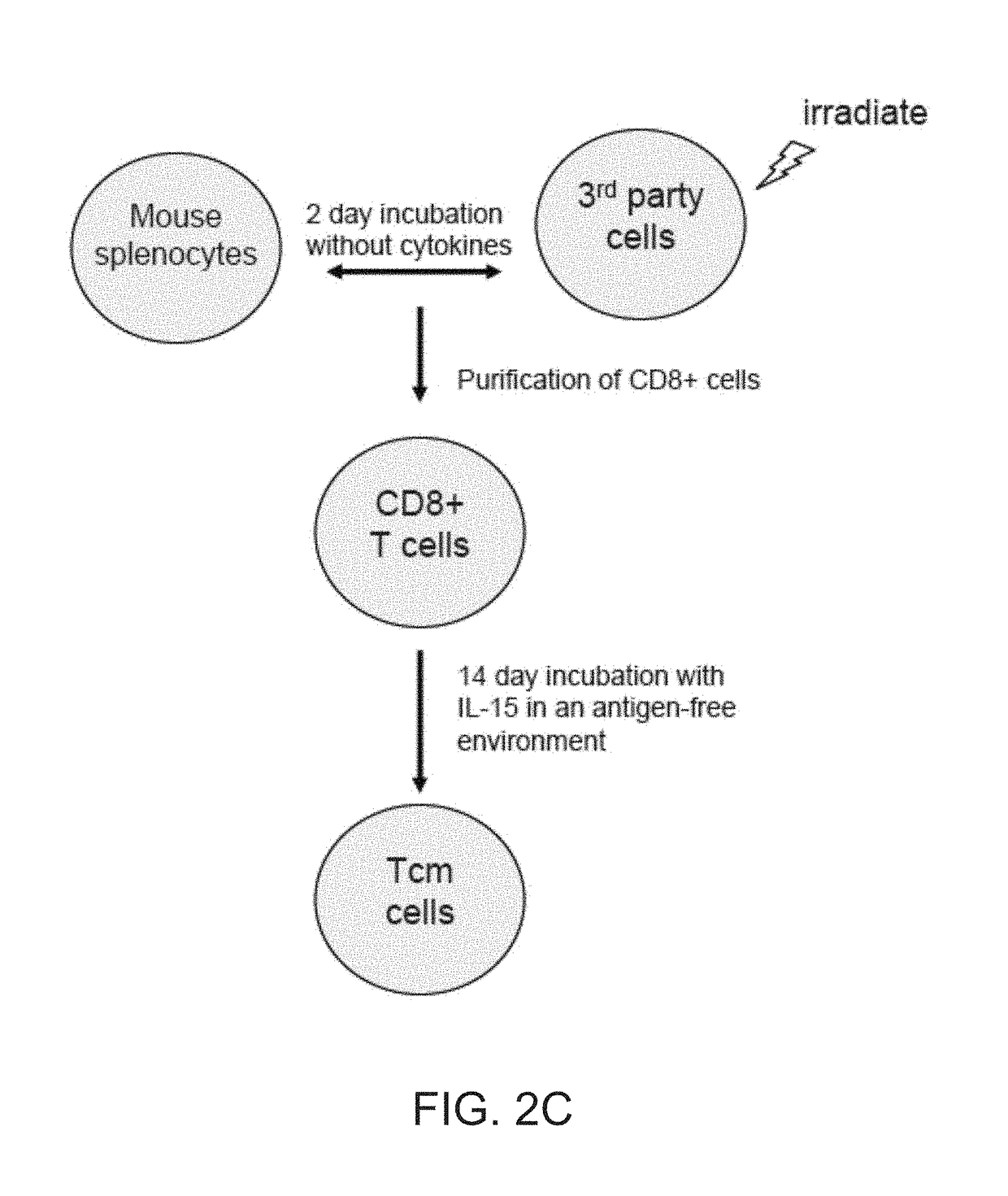Anti third party central memory T cells, methods of producing same and use of same in transplantation and disease treatment
a central memory and t cell technology, applied in the field of nongvhd inducing antithird party cells, can solve the problems of difficult barrier for donor cell engraftment, hampered strategy, disappointing clinical outcome of t cell depleted bm,
- Summary
- Abstract
- Description
- Claims
- Application Information
AI Technical Summary
Benefits of technology
Problems solved by technology
Method used
Image
Examples
example 1
General Materials and Experimental Procedures
[0155]Animals
[0156]6-12 week old female mice BALB / c (H-2d), CB6 (H-2bd), FVB (H-2q), SJL (H-2s), C57BL / 6 (H-2b), C3H(H-2k), Nude-BALB / C and Nude-057BL / 6 were obtained from the Weizmann Institute Animal Center (Rehovot, Israel). C3H and BALB / C mice were crossed to generate (C3H×BALB / C) F1 mice. A breeding pair of Transgenic (Tg) H-2b mice expressing the TCR from the CTL clone 2c with specificity for H-2Ld was kindly provided by Janko Nikolic-Zugic (Sloan-Kettering, N.Y.). Progeny of these Tg mice were bred at the Weizmann Institute Animal Breeding Center. All mice were kept in small cages (five animals per cage) and fed sterile food and acid water.
[0157]Preparation of Host Non-Reactive Donor Anti-3rd Party CTLs
[0158]Anti third party CTLs were prepared as was previously described by Bachar et at. [Bachar-Lustig et al., Blood. (2003) 102:1943-1950]. Briefly, splenocytes of the donor mice were cultured against irradiated (20 Gy) FVB mouse spl...
example 2
Homing Patterns of anti 3rd-Party Veto CTLs (Previously Described) in Comparison to Syngeneic and Allogeneic Naive T Cells
[0184]While generating host-nonreactive veto CTLs, the cells underwent prolonged ex-vivo activation against 3rd party stimulators in the presence of IL-2. As a result, the cells have likely developed into effector CTLs, which were previously shown to exhibit an inflammation-seeking phenotype with loss of homing capabilities to the lymph nodes (LNs) [Reinhardt et al., Nature (2001) 410:101-105; Weninger et al., J Exp Med. (2001) 194:953-966; Masopust et al., Science (2001) 291:2413-2417]. Such a migratory pattern could be one of the reasons for the discrepancy between anti 3rd-party veto CTLs efficiency in vitro and in vivo. To test this possibility, the inventor of the present invention has used an in-vivo model to test the efficacy of veto anti-3rd party CTLs. This stringent model comprised lethally irradiated mice which received allogeneic T cell depleted bone ...
example 3
Induction of Anti 3rd-party Tcm Cells In Vitro
[0187]The inventor of the present invention has previously developed anti-3rd party CTLs which exhibit marked veto activity (due to their FasL expression) and which are devoid of GVHD reactivity by virtue of their prolonged activation against a 3rd party [Bachar-Lustig et al., Blood. (2003) 102:1943-1950]. However, as depicted in Example 2 above, these cells exhibited poor LN homing. These results have lead the inventor of the present invention to attempt to further improve the reactivity in-vivo of these cells by trying to induce central memory (Tcm) phenotype in these cells upon their activation against a third party. The Tcm phenotype has been previously shown to be associated with activated cells (CD44+), which express, among other surface antigens, CD62L and CCR7 that enable their homing to the LNs [Sallusto et al., Nature (1999) 401:708-712; Weninger et al, supra; Masopust et al., supra].
[0188]Thus, the present inventor has tested ...
PUM
| Property | Measurement | Unit |
|---|---|---|
| durable | aaaaa | aaaaa |
| veto reactivity | aaaaa | aaaaa |
| GVH reactivity | aaaaa | aaaaa |
Abstract
Description
Claims
Application Information
 Login to View More
Login to View More - R&D
- Intellectual Property
- Life Sciences
- Materials
- Tech Scout
- Unparalleled Data Quality
- Higher Quality Content
- 60% Fewer Hallucinations
Browse by: Latest US Patents, China's latest patents, Technical Efficacy Thesaurus, Application Domain, Technology Topic, Popular Technical Reports.
© 2025 PatSnap. All rights reserved.Legal|Privacy policy|Modern Slavery Act Transparency Statement|Sitemap|About US| Contact US: help@patsnap.com



